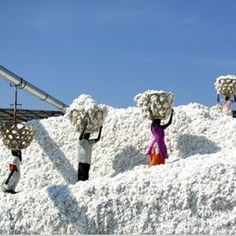Reviving Indigenous Cotton in India: A Path to Sustainable Agriculture and Ethical Fashion
India has a rich history of cotton cultivation, with indigenous varieties being woven into the cultural and economic fabric of the country for centuries. However, the rise of genetically modified (GM) cotton and the dominance of industrial farming practices have threatened the survival of traditional cotton species. Today, a growing movement is working to revive indigenous cotton farming, driven by a desire to promote sustainable agriculture and ethical fashion. This revival offers the potential for environmental, social, and economic benefits for farmers and consumers alike.
The Decline of Indigenous Cotton Varieties
Historically, India was home to diverse indigenous cotton varieties, known for their resilience, natural pest resistance, and ability to thrive in local environments. However, the introduction of GM cotton in the 2000s—particularly Bt cotton, which is engineered to resist pests—led to a decline in the cultivation of traditional varieties. Additionally, the shift to large-scale industrial farming practices, often reliant on heavy chemical inputs and water-intensive irrigation, has negatively impacted soil health, biodiversity, and farmers’ livelihoods.
As industrial cotton farming spread, farmers became increasingly dependent on external inputs, leading to environmental degradation and rising debts. These changes, coupled with the loss of traditional knowledge about cotton cultivation, put indigenous cotton varieties at risk of extinction.
Efforts to Revive Indigenous Cotton
In recent years, there has been a concerted effort to revive indigenous cotton farming, especially in regions such as Kutch in Gujarat, Punjab, and Rajasthan. These efforts are being led by a combination of grassroots organizations, non-governmental organizations (NGOs), and small-scale farmers who recognize the importance of preserving biodiversity and returning to more sustainable agricultural practices.
One key initiative is the promotion of Khadi, the handwoven fabric that has deep cultural roots in India, championed by Mahatma Gandhi. Khadi cotton, which is often produced from indigenous cotton varieties, is gaining popularity for its natural, chemical-free cultivation process and its low environmental impact. Efforts to revive indigenous cotton farming are being integrated into the broader push for sustainable textiles, emphasizing organic and local production.
Additionally, a number of Indian cooperatives and farmer collectives are working to encourage the cultivation of traditional cotton. These initiatives aim to offer farmers better economic returns, reduce their reliance on harmful pesticides, and promote organic practices that improve soil fertility and water usage.
The Role of Ethical Fashion
The revival of indigenous cotton is also a response to the growing demand for ethical fashion and sustainable textiles. Consumers, particularly in the global North, are increasingly aware of the environmental and social costs associated with fast fashion. The cotton industry, in particular, has been criticized for its reliance on pesticides, water consumption, and labor exploitation.
By supporting the cultivation of indigenous cotton, ethical fashion brands are not only promoting sustainable farming practices but also ensuring that artisans and farmers receive fair compensation for their work. The use of traditional cotton varieties ensures that garments are free from harmful chemicals and are produced using eco-friendly methods that respect local ecosystems.
Moreover, many designers and fashion brands are incorporating indigenous cotton into their collections, creating a market for high-quality, locally sourced textiles. This provides new economic opportunities for small-scale farmers and supports rural economies by connecting them with global markets.
Environmental and Social Benefits
Reviving indigenous cotton farming contributes to sustainable agriculture in several ways. Traditional cotton varieties require fewer chemical inputs and pesticides, reducing the environmental impact of cotton cultivation. These varieties are often better suited to local growing conditions, reducing the need for excessive water use and making them more resilient to climate change. Additionally, by avoiding the monoculture practices associated with GM cotton, indigenous cotton farming helps preserve biodiversity and maintains healthy ecosystems.
From a social perspective, the revival of indigenous cotton farming helps empower local communities. By promoting fair trade practices and paying farmers a premium for their cotton, these initiatives support rural livelihoods and reduce the economic pressure on farmers who often face debt traps due to rising costs and low returns from industrial cotton farming.
Conclusion
The revival of indigenous cotton farming in India represents a critical step toward sustainable agriculture and ethical fashion. It offers an opportunity to restore biodiversity, improve environmental practices, and support the livelihoods of small-scale farmers. At the same time, it addresses the growing demand for sustainable and ethically produced textiles. As the movement gains momentum, it holds the potential to transform both India’s agricultural landscape and the global fashion industry, making a significant contribution to a more sustainable and just future.

